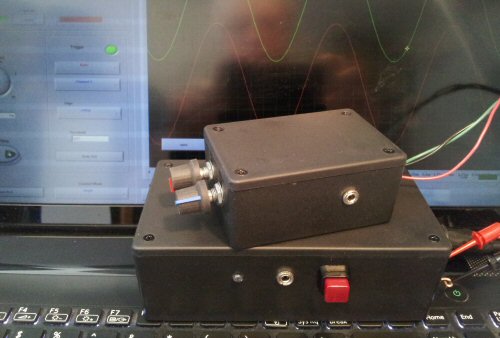Sound Card Oscilloscope: Build Better Electronics Projects - Companion
Books Home |
Parts List |
Breadboard template |
Stripboard template |
Image gallery
Sound Card Oscilloscope - Build Better Electronic Projects is in the Kindle store now. Click a country below for the Amazon store in your area United States United Kingdom Germany India France Spain Italy Japan Brazil Canada Mexico Australia 
You can build an oscilloscope cheaply and quicklyWhen I realized that the sound card on your PC can be used as the input for an oscilloscope application I felt compelled to build one. Not because I needed an oscilloscope because I already had a good one. I wanted to make sure that this wasn't one of those "too good to be true" stories. It does sound like it I admit but I can tell you that it isn't anything of the sort. You really can build yourself an oscilloscope for a handful of dollars. Yes it is limited by the capabilities of the sound card but I've managed to find many uses for mine since I built it. I'm so excited by the power and simplicity of this device that I've written a book about it. I've included everything that you need to know to enable you to build an oscilloscope and calibrator and an impressive signal generator into the bargain. The book is called "Sound Card Oscilloscope - Build Better Electronics Projects" and it has turned into a substantial work that is now on sale in the Amazon Kindle store. Once you get your hands on this ebook you need never be caught without an oscilloscope to probe your circuits with ever again. It makes full use of the excellent software provided by Christian Zeitnitz which is completely free for private use and fully described in the ebook. I also describe the more sophisticated but a little more difficult to use Visual Analyser software. This software is also free to use so you can have both applications on your computer. The main project is an improved version of the PC sound card probe design together with a detailed description of how I built the circuit and housed it in a small plastic enclosure. The box measures only 87 x 57 x 39mm (3.5 x 2.2 x 1.5 inches) and sits nicely on the desk next to your PC.
The cost of building the Sound Card Oscilloscope is very low. I got most of my parts from Rapid Electronics in the UK because that's where I live. It cost me less than you might pay for coffee and cake in town. You can however get all the parts you need from Amazon if you want to. Click to see the parts list now. But it doesn't stop there. Also in the ebook are detailed designs for an oscilloscope calibrator and a signal generator. You don't have to build this additional project to use the Sound Card Scope probe effectively but if you do it will complement your setup nicely providing you with some formidable test gear for very little money. You will also learn something about oscilloscopes, what they can do and how you can use them to help design and/or build working electronics circuits. The ebook is packed full of detailed explanations, practical experiments and case studies to illustrate why the Sound Card Oscilloscope is such an indispensable tool to have around.
|
| Now subscribe to our newsletter and don't miss a thing |



Comments (14)
Seems to be only Kindle format and saved to kindle cloud. Any other formats available?
Fantastic book, very clear and easy to follow with a very practical approach to explaining the project. Highly recommended. Regards
Cheers
Steve
Add Comment